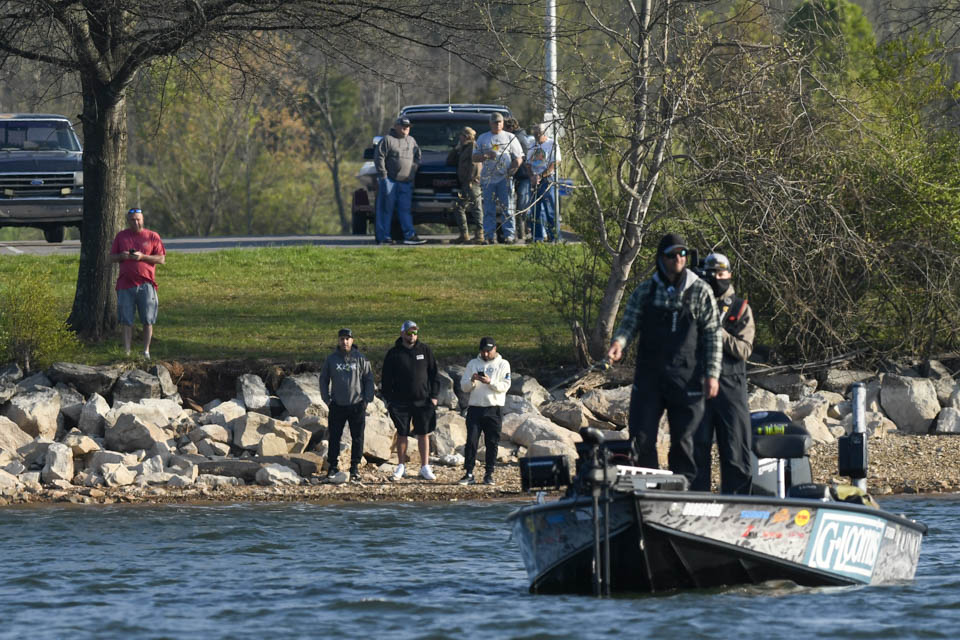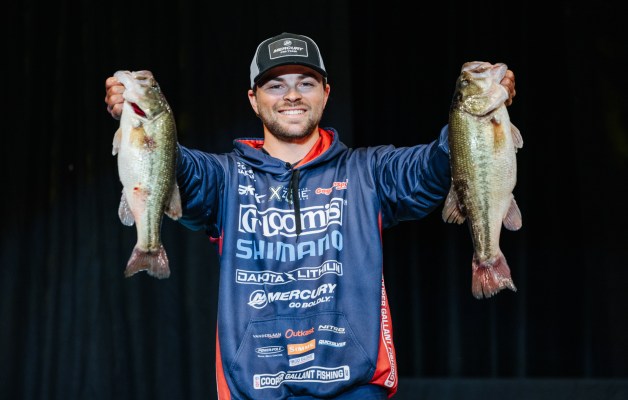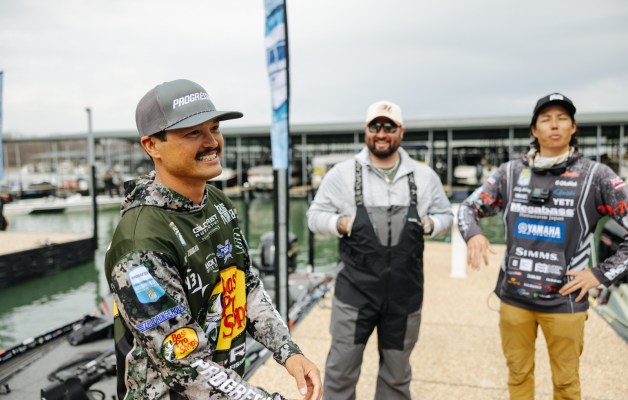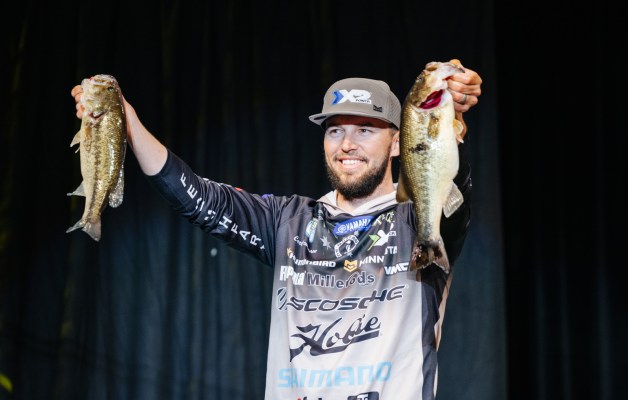
KNOXVILLE, Tenn. – Just over four years ago, the bass fishing world descended upon Knoxville for another Academy Sports + Outdoors Bassmaster Classic presented by Toyota, and in the ensuing relatively short blip on the long arc of history, the nature of the event has changed substantially.
The mostly-new set of qualifiers is a big part of the image change, but the bigger story as far as I can tell is the altered nature of the competition. We’ve previously seen supposed “game changers” – the Senko, the Chatterbait, the Alabama rig, Power Poles and so on – but none of those have had an impact nearly as big as forward-facing sonar. It was around in 2019, but it had not become the all-consuming force that we’re experiencing now.
As Jason Christie told me after pulling the boat out at the end of Wednesday’s final practice day: “I think forward facing sonar will play some sort of role in every tournament we fish from here on out.”
So far that’s proven to be true. Even at grass-laden, super-shallow Okeechobee, Tyler Rivet made it work for him to the tune of $100,000. Today’s generation of anglers are inclined to look for ways to utilize it, rather than ways to ignore it.
Historically, it might be our “Fosbury Flop” moment.
Fifty-five years ago, Olympian Dick Fosbury, who regrettably passed away earlier this month, set the world of high-jumping on its ear – or, on its back, as the case may be. Until then, high jumpers had used the straddle method to get over the bar, facing it the entire time. Fosbury reasoned that by going back first, he could attain more distance. It looked ridiculous to the contrarians – as most truly historic iterations or changes do – but no one could deny the results. Fosbury proved them wrong and had the gold medal to prove it.
After his win, high jumpers didn’t need to do the Fosbury Flop to podium, but increasingly it became obvious that for most it provided a competitive advantage. In the 1972 Olympics, 28 of the 40 high jump competitors were looking away from the bar when they went over it. Between 1972 and 2000, 34 of the 36 medalists followed Fosbury’s fantastically flopping example. They didn’t have to do so to have success, but the evidence said you couldn’t dismiss the development completely – at least not if you wanted to maximize your performance consistently.
The advances in sonar have affected professional fishing that way – maybe not quite to the same extent, but close.
“Forward facing sonar is fun to do if you’re the one doing it,” Mark Zona quipped this morning.
If that’s the case, then no one had more fun in Knoxville today than Jeff Gustafson. He finished out a limit of 18-inch-plus smallmouths (well, with one outlier, as you’ll read below) around 10 AM, video gaming them all, and then spent the rest of the day expanding on his practice.
Here’s what I saw and thought as I watched the anglers compete and then picked their brains after the weigh-in:
Could’ve been worse – Gussy had to release multiple smallmouths over 17-inches early today, including one that came within about an 1/8 of an inch of measuring. Per his usual persona, he never seemed to get flustered by that, but the difference between an 18 pound, 8 ounce bag of smallmouths and a goose egg is a fine line on this pond.
Mean and green – or brown – All week long I’ve been asking the anglers whether they planned to focus on largemouths, smallmouths or a mix of the two. Apparently my question was wrong, or at least incomplete. One of Gustafson’s first keepers was a “meanmouth,” a hybrid species of black bass, usually either a smallmouth/spot or smallmouth/largemouth. B.A.S.S. Conservation Director told me that in this system most are combos of smallies and what are now known as “Alabama Bass” (formerly “Coosa River Spotted Bass”). In Tennessee waters, the higher of the two length limits applies, so it had to be 18 inches long to keep, and it exceeded that mark.
Evolution of techniques – Not every new technique or skill is as significant globally as forward facing sonar, but anglers who don’t evolve will die on the vine. John Cox (fourth-place, 14 pounds 4 ounces) is pretty lax when it comes to obsessing over electronics, but he continues to add new lures to his quiver. “I didn’t even throw a crankbait four years ago,” he said, but today much of his success came on a Berkley Frittside. That’s the same bait he used to win $100,000 at an FLW Tournament on Sam Rayburn in 2020. He’d like to add about three times that much to the total this week. What makes it so good? “I don’t know, but it catches the crap out of them.”
Cut Weights – I always apply the (2X+1) rule to Day 1 results to try to figure out what I’ll take to proceed to Day 2. In 2019, Ott DeFoe ruled the first day with 20 pounds even. Fifth place was 14-11. Tenth-place was 13-04 and the 25th place man – just inside the cut – sat at 9-04. The fifth and 10th place weights effectively doubled – 28-09 and 26-07, respectively. The cut man had 20-01, which was just about 2X plus a pound and a half. Right now, fifth, 10th and 25th are 14-02, 12-09 and 9-04. In other words, the current cut is just the same and the other markers are quite close.
Limited time only – On Day 1 in 2019, the top 12 anglers and 30 of 52 competitors weighed in a limit on Day One. Today, the Top 10 had limits and 24 of 55 brought five to the scales.
Big fish bonuses – Ott DeFoe’s 2019 Day 1 leading bag included a 6-pound largemouth. Five-pound-plus bass – brown or green – aren’t common here, but they do exist, and one can take a 12-pound bag up to 15 or possibly more, depending on what needs to be culled. Today, Chris Johnston’s 4-15 was the big fish – expect that mark to fall tomorrow and/or Sunday.
Start early, stay late – Brandon Lester caught his weight after 11:30, most of it during a 30-minute flurry in one key area. At the dock this morning he told me that he expected fishing to get better as the day progressed and that clearly proved accurate. While he admitted that he was starting to get nervous approaching midday, the way the afternoon played out today gives him faith to persevere tomorrow. “I’m going to go into it with the mindset that anything I catch before 10 o’clock is a bonus,” he said.
Go Speed Racer – Over the years, we’ve seen some disgruntled anglers go through the media room without stopping, but no one has ever moved through as quickly as Chris Zaldain’s Belgian Malinois Micci, who vaulted inside and away from Chris, possibly with an eye toward freedom – or the buffet table. Luckily, she’s been trained well enough to come back when called, and after heeding her master’s initial call she then made a lap of the room, building friendships.
Here’s who I’m watching – Obviously, the leaders will deservedly get massive attention tomorrow, and they may keep up the momentum, but things frequently seem to flip flop at least a little. In 2019, DeFoe notched only a little over 10 pounds on Day 2 and fell to fourth before coming back to win on Sunday. Here are three anglers outside of the top five who could become players: (1) Jason Christie (12th place, 12-06, 6-02 back), because no amount of pressure will faze him; and (2) Keith Poche (15th, 11-02, 7-06 back) fresh off a win on another circuit, who stayed in contention today fishing by his instincts on minimal practice; and (3) Matt Robertson (17th, 10-15, 7-09 back), who only weighed in three fish today. He has not caught more than three on any practice or competition day, but says that if they bite his cricket, he has 20-to-25-pound potential.
Quote of the Day – Matt Robertson: “Gussy’s the nicest guy in the world, literally. He’s the only person I can beat at wrestling, so he might as well win the Classic.”





